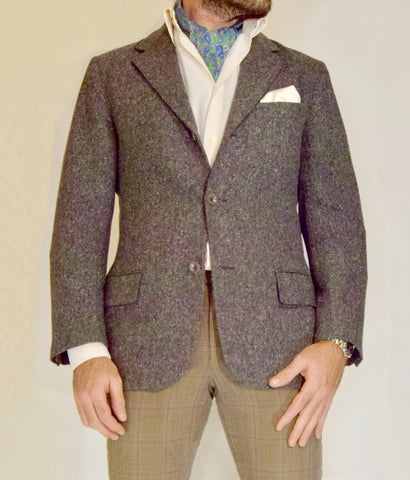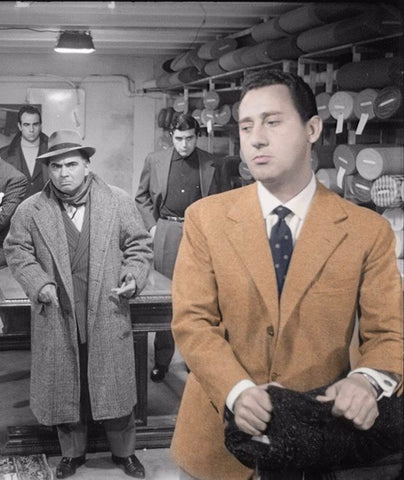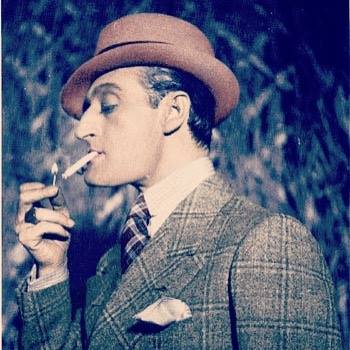
Somewhere in between. Remember our Roman motto? In medio stat virtus. The first chapter of the book which deals with the concept of “causal”, or sportswear – if you wish – represents some sort of a rite of passage. This makes sense because the more you venture into the windy road of casual style, the harder it is to establish borders, the fewer rules you will encounter. Let me introduce you to the fantasy world of casual style.
I’ve spent the last chapters on formal style dispensing rules and commandments. Now I’m telling you: forget everything I said. Casual is casual is causal. It means that you don’t have to carefully match colors and textures and calibrate outfits to events and venues. The key word is “relax”. When you dress casual, supposedly, you are not working and – even if you are – your job is probably some sort of creative job.
You might be tempted to ask: “Am I supposed to just grab what comes out of my closet and put it on?” I’d say yes, in a certain sense. Like the skilled guitarist picks the strings on the right spot of the fretboard at the right time, with the proper intensity, gusto and intention, and it always looks as if he is able to play effortlessly, you should be able to pick and choose each and every single item of your outfit with the same ease. Although, one might be fooled into thinking that the guitarist is merely exhibiting talent, while in reality the exciting music your ear is the result of years and years of boredom and exercises. Much in the same way, the experienced dresser can actually pull out the perfect item from the wardrobe only because he has carefully trained his eyes and his mind to mix and match colors and texture for years and years.
Just to give you an idea: I bumped into one of the thousands upon thousands of articles written by a self-proclaimed style guru on one of the most important Italian newspapers the other day, and the title caught my attention because it had to do with neckties. It was entitled “Knots, length, color: the rules of the necktie”. I started reading and soon realized that I was faced with another one of the many “10 style tips” articles that are coming out these days. The article was superficial, but at least correct. The only problem I had with the piece was the excerpt and the conclusion. The major piece of advice went something like this: “the most important thing to remember when it comes to choosing your necktie is, let your feeling of the moment and your intuition be the leading factor in your decision”. I couldn’t disagree more, in fact, I have even commented the article with something that went, more or less, like this: “if you know nothing about colours, textures, bon ton and dress codes and you follow your intuition, it will most probably lead you to wear the wrong necktie in the wrong place, at the wrong time. The path to hell of style is paved with good intentions.” This being a communist, Godless country, they didn’t publish the comment, of course.
Now, when it comes to casual style: you understand what I mean when I say that, in a certain way, you can actually grab whatever comes out of the closet, provided you know what you are doing? It makes sense, doesn’t it?
The combo you see in here is composed of an off-the-rack Tombolini, two-buttons sporty jacket made in wool with notch lapels and flap pockets, the color of Gunmetal Grey, which was tailored to fit my measure by my Tailor/friend Marian Vitel, a pair of wonderful five pockets in cotton, the color of Cocoa Brown, finished with a windowpane pattern by Teleria Zed, a pair of Guess sneakers in charcoal grey, a dark grey driving cap by OVS, a white button-down cotton shirt by MOSCA ’54, an ascot tie made in silk in Nantor green with a pink&blue paisley pattern by the Tie Shop Rome (don’t bother searching for it, it’s a limited edition) as well as an off-white satin silk pocket square, also by the Tie Shop Rome. Looking closely, the earnest among you, might even notice I’m wearing a vintage Rolex Oyster (datejust).
The most important thing that must be said about this outfit is: it isn’t properly formal, and it isn’t properly casual. I’d say, however: it’s more casual than formal, for sure. Maybe we could call it “formual?” To put it in terms of wearability, I don’t think it’s formal enough for a Friday at the office, but it would be perfect for the nine o’clock cocktail party, the same day.
This is your first step in the fantasy world of sportswear, ladies & gentlemen, in medio stat. formual…
ALSO ON "A GENTLEMAN IN ROME"
As you probably know already, a blazer is different from a jacket because of its original purpose: these were common items in the wardrobes of Captains during the good-old fashioned age of navy battles, when men used to be the breadwinners, wear pants and never moan about circumstances (or days of the week), and the women used to be amazing, wonderful, sensitive creatures with long skirts.

I’ve been hesitating about this guy. I mean, I love him and his movies, but his style is not my style. However, he is here for a straightforward reason: Sordi represents - like perhaps nobody else - the average Italian, or the “Mario Rossi”, if you will (Average Joe). To be even more precise, Sordi is the quintessential Modern Roman Gentleman.
For those of you who have never heard of him: Sordi is regarded in Italy, and especially among Romans, as some sort of popular hero. His movies have entered the collective imagination of modern Italian culture and many of his famous quotes are an integral part of idiomatic Italiano. Italian comedian and director Carlo Verdone, with whom Sordi was very close, once stated during an interview that his mentor was some sort of “Radical Catholic”. He was probably hinting at the fact that Sordi was a true believer, but nevertheless, no exactly what you call your average Catholic. To give you an idea of his personality, here’s a famous quote. Sordi was once asked why he wasn’t married and he answered: “Me, Married? Do you really expect me to put a stranger in my home?”
Alberto Sordi was not just an extremely prolific actor (200 movies circa), but also an accomplished director and, most importantly, he was made a “Knight of Grand Cross” of the Italian Republic and that’s an incredible accomplishment. He also received many official recognitions for his work - for example, seven “David di Donatello” film award, among others. But some say that the most important achievement of his career was the unconditional love of his fellow Roman citizens. When he passed away following a heart attack back in 2003, a crowd of almost a million people gathered at the Basilica of St. John Lateran to say goodbye. Some claim that when Pope John Paul the Second gave up his ghost two years later, the piazza wasn’t as crowded.
However, we are here to discuss Sordi’s style. And the only reason why I spent a few extra-words for his bio is because I miss him. I feel sorry for all the people that will never be able to enjoy one of his movies, because they can’t really understand Italian. But, as I said, Sordi style is not exactly my cup of tea. There was too much London in his outfits. One may think that one can never be too British when it comes to dressing well, but I would object. You see? If you were born and raised in Italy, then you must act and dress like an Italian, it isn’t a question of choice: it’s imperative. National identity being crucial for personal development and cultural identity. An healthy fascination with foreign cultures is auspicabile in a gentleman (especially with Anglo-Saxon culture), but excess is never a good thing. “In medio stat virtus”, the ancient Romans used to say: virtue is to be found in the balance between too much and too little of anything.
This is the reason why I picked this outfit for Sordi: it is simple, classical, well put-together, timeless. Camel jackets are perfect in wintertime, they are somewhat hydro-repellant and they can easily keep moisture and cold winds at bay. Style must be functional, remember? Add a camel jacket to your wardrobe and you will always have something to wear in wintertime. Some modern Men’s Style websites and self-proclaimed style gurus would want you to pair a light-brown camel jacket with black pants. Don’t do that! Black and brown NEVER go well together. Go for Navy blue, instead. The muted color of the jacket would still pop-out, but you’ll be safe from the sarcastic remarks of the usual connoisseur that always lurks around the corner when you decide to go for the “personal” style approach, and that would be me: God forgives, John Cravatta doesn't. Remember, you aren’t a trend-setter, the Duke of Windsor or even Gianni Agnelli: play safe.
Notice how, Sordi being a Roman, he effortlessly understands the brown-with-blue rule: his madder tie is also simple and works perfectly with the ensemble. Also, notice how well he tied his necktie. That’s an half-Windsor know, correct: Sordi loved Windsors and half-Windsors, that’s one of the main reasons why I don’t like his style. The “fighetta” (little pussy), is there and it is perfect. Huh, pardon: that would be the dimple. Romans sometimes can be quite rude. There’s another thing or two to point out about the necktie and about how Sordi understands style quite effortlessly: that’s an English-spread collar you see on that shirt, which means that the choice of an half-Windsor knot is quite appropriate indeed: bravo, Alberto!
The other thing being: the slope! The necktie doesn’t look like a dying roadkill on the chest, but it’s lively instead. Consider also geometry: look at how the cuts of the collar form a continuum with the lapels on the jacket and go well with the knot as well. On this point, come to think about it: here’s the problem with the ensemble: the necktie is too thin for those lapels. However, the color of the shirt is appropriate (notice there are cufflinks, instead of buttons) and the choice of the wristwatch too. So, we’ll forgive Alberto this minor mistake.

A.K.A. “Totò”, or “The Prince of Laughter” (he’s full name being “Antonio Griffo Focas Flavio Angelo Ducas Comneno Porfirogenito Gagliardi de Curtis di Bisanzio”), is considered one of the most influential Italian actors of all times. Think of him as the Italian Buster Keaton, or Charlie Chaplin, if you wish, but add some more class and stir well. You’d probably end up with some sort of distorted idea of who this genius really was.
God bestowed on this little “scugnizzo” (Neapolitan for “boy”) so many talents, that it was hard for him to pick just one and work on it. Apart from being a great comedian, Totò was - in fact - also an accomplished poet and musician. Not to mention the fact that he was also, certainly, a gentleman.
In this endeavor of ours, however, we are far more concerned with his sense of style than anything else. Obviously, he was also a great dresser. So, I will skip Totò's bio and comment on this wonderful, colorised picture. Let’s start from the centrepiece: this double-breasted madras flannel jacket in storm dust green with peaked lapels is breathtakingly wonderful, to say the least. And look at that Homburg Hat in hemp brown! What a perfect companion! Not to mention the Tartan necktie in Seal Brown and dark blue and the white checkered shirt. Perfection doesn’t need many comments, it speaks for itself. Should I mention the silk pocket square and the way it has been folded? This picture was taken when Totò was still relatively young, but think about it: wouldn't this outfit be stylish, even today? Of course it would.

Vittorio de Sica is one of the greatest Italian actors of all times, as well as of the most influential figures in neorealism, there is no arguing about that… “Bicycle Thieves”, anyone? De Sica is the perfect example of how you can become a gentleman, even if there isn’t a single drop of blue blood in your veins. De Sica’s humble origins might have been an obstacle, but this obstacle did not prevent him to become one of the greatest dressers in Italy.
Now, take a very close look at this ensemble: This picture was taken on the set of “L’Oro di Napoli” (The Gold of Naples) and it was in black&white before I personally colorised it. I LOVE the way it looks now. I’ve used a very dark shade of blue for that fantastic, slack, nails-head wool jacket with peaked lapels, and then I went for dark burgundy for the madder necktie, and light-brown for the vest. Moreover, I coloured the horizontal candy stripes of that sublime white shirt with contrasting white club collar. I left the pocket handkerchief in dark grey and white, because I didn’t want to add more colours. Also, I think it looks great with the ensemble.
I would like you to notice three things here: first the small four-in-hand knot, which is quite appropriate given this collar. Second, the arch of the tie: thumbs up to good-old De Sica for that. Third, the way in which the pocket handkerchief has been placed inside the pocket. What can you say about it? It’s just random and that’s how it should be. I see way too many types of folds in nowadays pictures. But the handkerchief is functional, it’s there because it serves a purpose, therefore it shouldn’t be used as a “peacocking” element. What else can you say about the ensemble? There’s a lot going on, right? Careful: if you’re a beginner, you just can’t pull this outfit off: you would look uncomfortable. It works on De Sica, because he’s a great actor and he’s used to dress like that.
But, you see? The micro nailshead pattern on the jacket works well with the checkers on the handkerchief because the difference in size. The same can be said about the figures on the necktie: they work well with both the candy stripes on the shirt and the checkers on the handkerchief for the same reason. More in general, the dark blue colour of the jacket and the other muted colours are a perfect match for the De Sica’s silver hair and his Caucasian skin tone. Finally, notice how the rounded collar of the shirt, worn without a pin, works wonderfully with both the ensemble and the peaked lapels and how it suits De Sica’s square face (it wouldn’t have looked equally as good on a round faced man). Anything else you notice?



